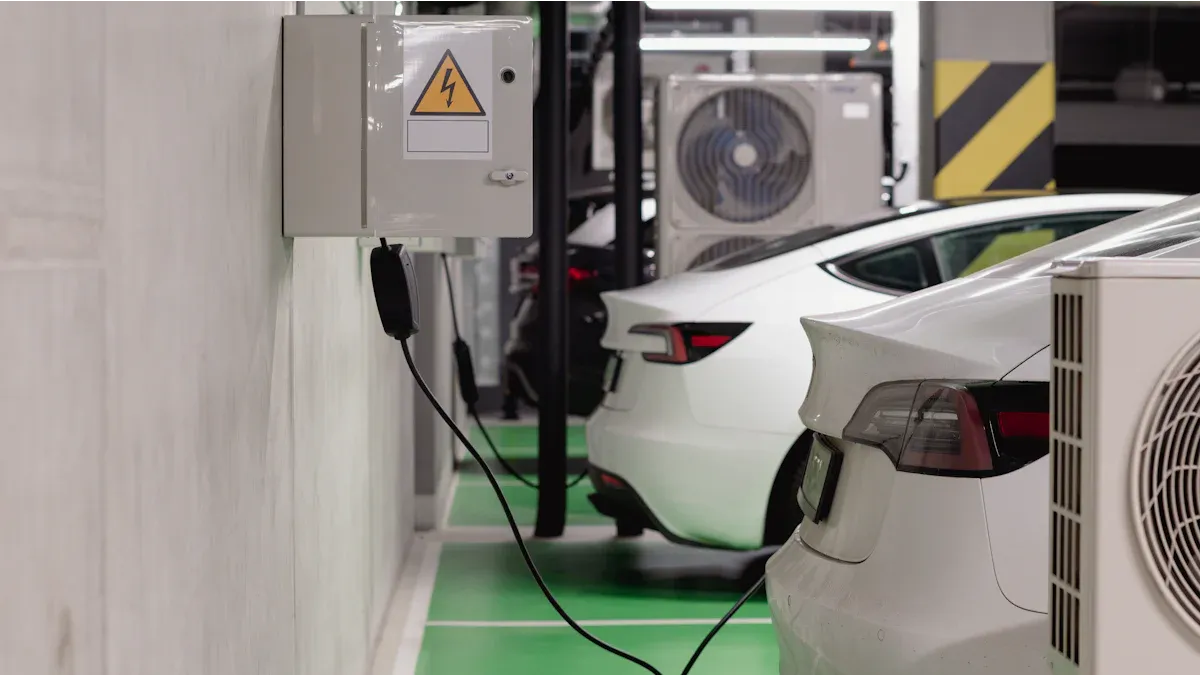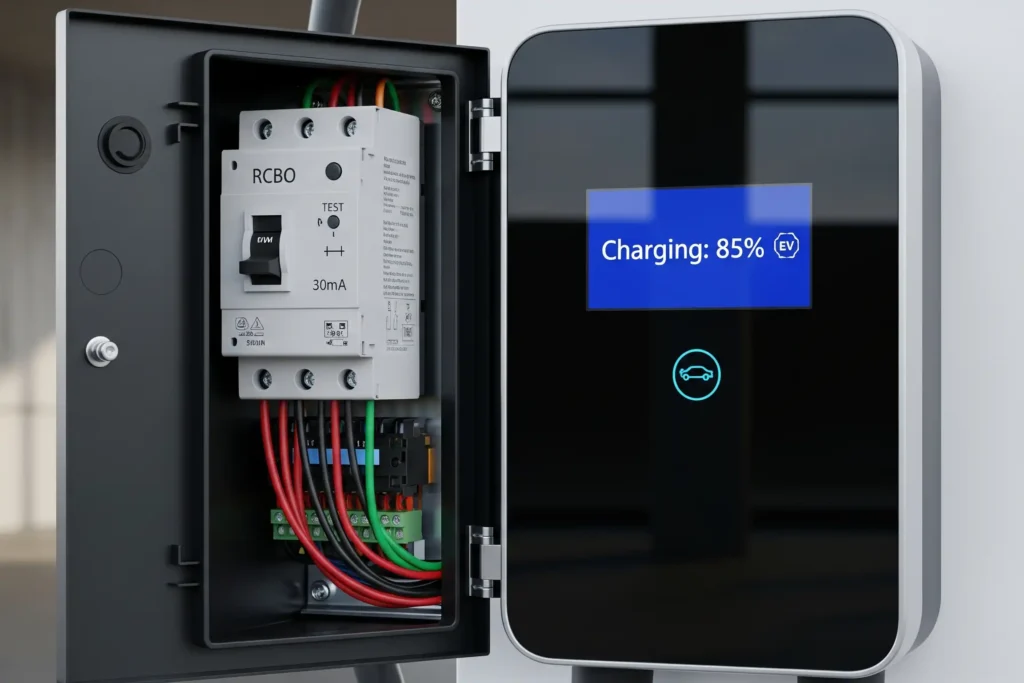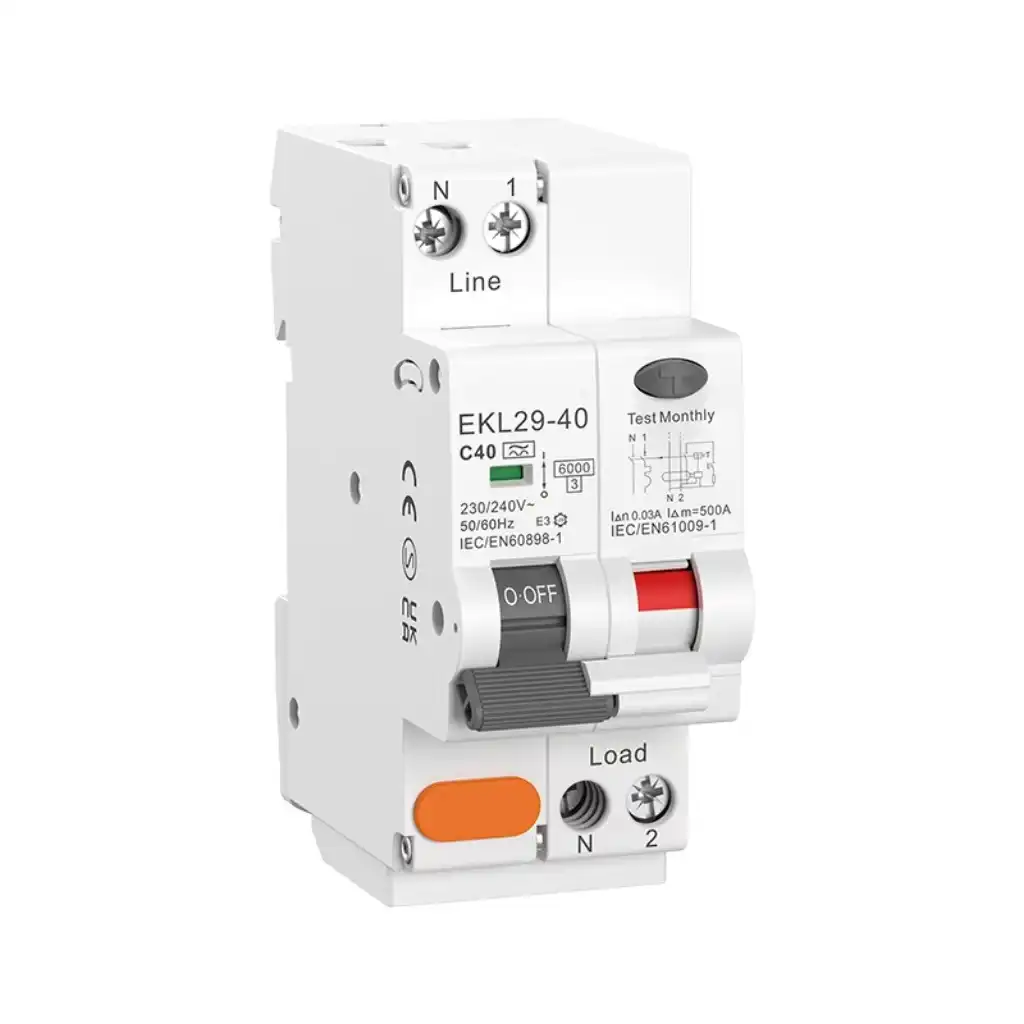You need protection that acts quickly and covers all risks. RCBO for electric vehicle chargers gives overload and residual current protection in one device. You get DC fault detection, which stops dangerous currents fast. Double pole isolation keeps you safe by cutting off both live and neutral wires. You meet strict rules and pass checks easily.
- Fast response keeps you and your equipment safe.
- Reliable operation means you worry less about electrical problems.
Key Takeaways
- RCBOs keep EV chargers safe by stopping too much power and leaks fast in one device. Type B and bi-directional RCBOs find every kind of problem, even smooth DC leaks that happen a lot in new EV chargers. Picking the right RCBO type and rating keeps you safe and stops wrong shut-offs when charging. RCBOs with safety marks help you follow local rules and make your charging setup safe and steady. Testing often and having a pro install it keeps your RCBO working right and your EV charger safe.
RCBO Basics
Definition
You need something that keeps your EV charger safe from big electrical dangers. An RCBO gives you two kinds of protection in one small device. It does what a Residual Current Device does, stopping earth faults and electric shocks. It also works like a Miniature Circuit Breaker, stopping overloads and short circuits. You do not need two separate devices for these problems.
Here is a simple comparison:
| Device | What It Is | What It Protects Against |
|---|---|---|
| RCBO | Mixes RCD and MCB jobs | Earth faults, leakage currents, overloads, short circuits |
| MCB | Regular circuit breaker | Too much current (short circuits, overloads) |
| RCD | Residual current device | Earth leakage currents, electric shocks |
An RCBO gives full protection for your EV charger circuit. This makes your setup safer and more dependable than using just an MCB or RCD.
How RCBOs Work
RCBOs keep track of electricity moving in your circuit. The device looks for two main dangers:
- Earth leakage currents that may cause electric shock.
- Too much current or short circuits that can hurt your equipment.
You get protection right away. The RCBO uses a special part to spot problems. If it finds a leakage current or overload, it shuts off the circuit fast—usually in 0.1 seconds at 30mA leakage. This quick action keeps you safe.
Double pole isolation means the RCBO shuts off both live and neutral wires at once. You do not have to worry about a live neutral wire, which can shock you. This is very important for EV charger setups. It also helps make fixing and checking things easier and safer.
You should pick an RCBO with real double pole switching for EV charging. The device follows world safety rules, so you get good protection every time you charge your car.
RCBO for Electric Vehicle Chargers

Current Ratings
When picking an RCBO, match its current rating to your charger’s power. This keeps your system safe and stops it from turning off by mistake. You can figure out the right rating with a simple math step. Divide the charger’s power (watts) by the voltage (volts). This tells you how much current your charger uses.
For example, a 7.2 kW charger on 240V uses about 30A. A 22 kW charger needs around 32A or more. Pick an RCBO with a current rating at least this high. Most home chargers use RCBOs rated at 32A or 40A.
- The RCBO’s current rating must cover all wires connected to it.
- The right size stops false trips and keeps protection strong.
- Check the tripping type (Class B, C, or D) to fit your charger.
- Fast shut-off during problems keeps people and equipment safe.
Tip: Always read your charger’s manual and local wiring rules before picking an RCBO. This helps you avoid mistakes and follow the rules.
Type B and Bi-Directional Protection
Modern EV charging needs better protection. Type B RCBOs can spot AC, pulsing DC, and smooth DC leakage. This is important because EV chargers can make smooth DC leaks. Type A RCBOs cannot find these, so Type B is needed for full safety.
- Type B RCBOs protect against AC, pulsing DC, and smooth DC leaks.
- EV chargers often make smooth DC faults only Type B can find.
- New rules suggest or require Type B RCBOs for EV charging and solar systems.
- You get both overcurrent and earth leakage protection in one device.
Bi-directional RCBOs give even more safety. They spot both AC and DC leaks, which is key for V2G and two-way charging. In these setups, power moves both ways—between your car and the grid. Old RCBOs only find AC faults, but bi-directional RCBOs find DC leaks too.
- Bi-directional RCBOs lower the risk of shocks and fires in two-way charging.
- They find and stop faults fast, keeping your system safe.
- Handling two-way current flow is important for V2G systems.
- These RCBOs work with new systems using solar and EV charging.
Note: Always pick RCBOs with world safety marks like CE and TUV. These show the device is safe to use. For example, the GEYA GYR10N-50 RCBO has CE, UKCA, SAA, and TUV marks and meets IEC/EN/AS/NZS 61009.1:2015. Certified RCBOs work safely in homes, businesses, and charging stations.
You should always check local rules, like the NEC in the US or UK wiring rules. These rules often say what kind of RCBO you need for EV chargers, especially for V2G systems.
Key Features
Overload and Residual Current Protection
An RCBO gives you two kinds of safety at once. It protects your EV charger from too much current and from earth leakage currents. You do not need two different devices for these dangers. This lowers the chance of wires getting too hot or someone getting shocked.
RCBOs work very quickly. They find problems and shut off power in milliseconds. This fast action helps stop fires, shocks, and damage to your charger. Regular circuit breakers only stop too much current. RCBOs also stop dangerous leakage currents. This makes your charging area much safer.
RCBOs turn off power faster and more often than regular MCBs. This helps prevent slow shut-offs that could cause big accidents.
You can use RCBOs with surge protection devices and consumer units. This gives you a full safety system for your EV charging spot.
DC Fault Detection
Modern EV chargers can make smooth DC leakage currents. Regular RCDs and RCBOs cannot always find these. Type B RCBOs use special technology to find AC, pulsing DC, and smooth DC faults. You stay protected even if the voltage drops.
- Type B RCBOs use fluxgate sensors to find smooth DC currents.
- They work well with three-phase EV chargers, where DC leaks happen more.
- These RCBOs still work if your charger has its own 6mA DC detection.
- Type B RCBOs let more DC leak before tripping, so you get fewer false alarms.
You must meet the 6mA DC fault detection rule from IEC 62955. If DC leakage goes over this, the RCBO shuts off the circuit. This stops “blinding,” which is when normal devices miss faults. Your charging setup stays safe and works well.
EV charging stations often make DC earth leakage currents that regular devices miss. Type B RCBOs are made for this and are needed in many places.
Compliance and Certification
You have to follow strict rules when setting up EV chargers. RCBOs for EV chargers must meet standards like IEC 61009 and IEC 61851. These rules cover safety, how well the device works, and if it fits with other equipment. In Europe, you also need CE or UKCA marks to show your device is safe.
- IEC 61009 is the main rule for RCBOs in homes and businesses.
- IEC 61851 is for electric vehicle charging systems.
- The UK Wiring Regulations (BS7671) and US NEC need RCBOs in many EV charger circuits.
- Type B RCBOs are best for Mode 4 DC chargers and setups with high-frequency leaks.
You should always check your local rules and follow what the maker says. Certified RCBOs help you pass checks and avoid legal trouble. They also keep your charging system safe and working well.
Tip: Pick RCBOs with CE, UKCA, or TUV marks. These show the device meets all important safety rules.
Installation Considerations
Space and Integration
You must make sure there is enough space in your panel. RCBOs for EV chargers are usually double pole. These take up more space than single pole breakers. Always look for extra slots in your consumer unit. The unit should be fire-resistant too. If your panel is full, you might need a bigger one or a sub-panel.
A qualified electrician should do the installation. They will check your main fuse and earthing system. If your supply is looped or the fuse is small, the electrician may call the utility company. Cables need good protection. For underground cables, use ducts about 50mm wide. Bury them at least 300mm deep. Inside, use PVC trunking to keep cables safe.
Each EV charger needs its own RCBO. You cannot share one RCBO with many chargers. This follows safety rules and stops unwanted trips.
Maintenance and Testing
You should test your RCBO often to make sure it works. Press the test button every few months. If you get a new charger or add more load, ask an electrician to check your system. They will see if your panel fits a double pole RCBO. They will also check if your wires can handle more current.
When you change your RCBO, pick a bi-directional one. These find both AC and DC faults. Modern EV chargers often have these faults. Upgrading helps keep your system safe and up to date.
- Check your RCBO and cables often.
- Use bi-directional RCBOs for better safety.
- Always get permits and follow local rules when you make changes.
Compatibility
You must check if your RCBO works with the RCD in your charger. Many chargers have built-in protection, but not all meet new rules. Look for a 30mA two-pole RCBO. It should turn off both live and neutral wires. Single pole devices are not safe enough.
| Aspect | What to Check |
|---|---|
| Built-in RCD | Meets IEC 62955 and has a test button |
| RCBO Type | Two-pole, 30mA, Type A or B |
| Manufacturer Specs | Matches consumer unit and charger requirements |
Ask your charger supplier for a Declaration of Conformance. This paper shows the built-in RCD is safe. Always follow the maker’s instructions. Use devices that work together to stop false trips and missed faults.
Good compatibility keeps your EV charging setup safe and working well for a long time.
RCBOs help keep modern EV charger setups safe. They protect against too much current and leakage in one device. This saves space and makes fixing problems easier.
- They act fast to stop shocks and fires.
- Only the broken circuit turns off, so the rest keeps working.
| Region | RCBO Guidance for EV Charging |
|---|---|
| United Kingdom | Type A or better (Type F or B) |
| Europe | Type A for new installations |
| Australia/NZ | Type A for modern appliances |
You should always follow local rules. Ask a trained electrician before you put in an RCBO.
FAQ
What does an RCBO do in an EV charger setup?
An RCBO protects your EV charger from overloads and earth leakage currents. You get both types of protection in one device. This keeps your charging area safe and helps you meet electrical safety rules.
What type of RCBO should you use for EV charging?
You should use a Type B RCBO for most EV chargers. Type B finds AC, pulsing DC, and smooth DC faults. This gives you full protection against all leakage currents from modern chargers.
What certifications should you look for on an RCBO?
| Certification | What It Means |
|---|---|
| CE | Meets EU standards |
| TUV | Tested for safety |
| UKCA | Approved in the UK |
You should check for these marks before you buy an RCBO.
What maintenance does your RCBO need?
You should press the test button every few months. This checks if your RCBO works. If you upgrade your charger, ask an electrician to check your system. Regular testing keeps your charging setup safe.
See also
RCBO residual current circuit breaker with overcurrent protection
Understanding RCBO Breaker Terminology Made Simple
RCBO and RCCB Explained for Beginners
Key Differences Between RCD, MCB, and ROCO Devices
Why RCBOs Need a Grounding Wire for Safety




